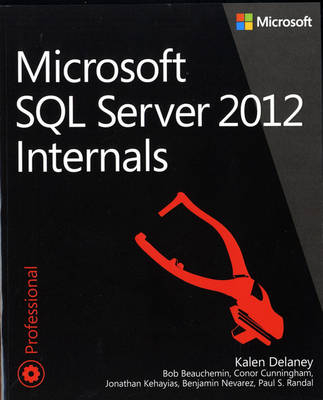
Microsoft SQL Server 2012 Internals
Microsoft Press,U.S. (Verlag)
978-0-7356-5856-1 (ISBN)
- Titel ist leider vergriffen;
keine Neuauflage - Artikel merken
Explore the core engine of Microsoft SQL Server 2012—and put that practical knowledge to work. Led by a team of SQL Server experts, you’ll learn the skills you need to exploit key architectural features. Go behind the scenes to understand internal operations for creating, expanding, shrinking, and moving databases—whether you’re a database developer, architect, or administrator.
Discover how to:
- Dig into SQL Server 2012 architecture and configuration
- Use the right recovery model and control transaction logging
- Reduce query execution time through proper index design
- Track events, from triggers to the Extended Event Engine
- Examine internal structures with database console commands
- Transcend row-size limitations with special storage capabilities
- Choose the right transaction isolation level and concurrency model
- Take control over query plan caching and reuse
Kalen Delaney, a Microsoft MVP for SQL Server since 1993, provides advanced SQL Server training to clients worldwide. She is a contributing editor and columnist for SQL Server Magazine and the author of several highly regarded books, including Microsoft SQL Server 2008 Internals. Conor Cunningham is principal architect of the SQL Server Core Engine Team at Microsoft.
Conor Cunningham is principal architect of the SQL Server Core Engine Team at Microsoft.
Paul S. Randal is a Microsoft MVP, trainer, and contributing editor for TechNet Magazine.
Chapter 1 SQL Server 2012 architecture and configuration
SQL Server editions
SQL Server installation and tools
SQL Server metadata
Components of the SQL Server engine
SQL Server 2012 configuration
SQL Server system configuration
Conclusion
Chapter 2 The SQLOS
NUMA architecture
The scheduler
Memory
SQL Server Resource Governor
Extended Events
Conclusion
Chapter 3 Databases and database files
Working with sample databases
Understanding database files
Expanding or shrinking a database
Using database filegroups
Altering a database
Setting database options
Understanding database security
Moving or copying a database
Understanding compatibility levels
Conclusion
Chapter 4 Special databases
System databases
The tempdb database
Database snapshots
Partially contained databases
Conclusion
Chapter 5 Logging and recovery
Transaction log internals
Changes in log size
Database backup and restore
Conclusion
Chapter 6 Table storage
Table creation
IDENTITY property
Sequence object
Internal storage
Constraints
Altering a table
Heap modification internals
Conclusion
Chapter 7 Indexes: internals and management
Overview
SQL Server B-tree indexes
Tools for analyzing indexes
Understanding B-tree index structures
Index creation options
Physical index structures for B-trees
Indexes on computed columns and indexed views
Data modification internals
Managing B-tree index structures
Columnstore indexes
Conclusion
Chapter 8 Special storage
Large object storage
FILESTREAM and FileTable data
Sparse columns
Data compression
Table and index partitioning
Conclusion
Chapter 9 Special indexes
Special indexes vs. ordinary indexes
XML indexes
Spatial indexes
Full-text indexes
Semantic indexes
Conclusion
Chapter 10 Query execution
Introducing query processing and execution
Reading query plans
Analyzing plans
Understanding data warehouses
Using columnstore indexes and batch processing
Conclusion
Chapter 11 The Query Optimizer
Overview
Search space and heuristics
Optimizer architecture
Statistics, cardinality estimation, and costing
Index selection
Partitioned tables
Windowing functions
Data warehousing
Updates
Distributed query
Extended indexes
Plan hinting
Hotfixes
Conclusion
Chapter 12 Plan caching and recompilation
The plan cache
Caching mechanisms
Plan cache internals
Objects in plan cache: the big picture
Optimization hints and plan guides
Conclusion
Chapter 13 Transactions and concurrency
Concurrency models
Transaction processing
Locking
Row versioning
Controlling locking
Conclusion
Chapter 14 DBCC internals
Shrinking files and databases
Consistency checking
Conclusion
Appendix About the authors
Über dieses Buch muss man nicht viele Worte verlieren: es ist einfach die absolute Pflichtlektüre für jeden, der SQL Server verstehen will oder muss. Die Grundlagen zu einer effektiven Optimierung von Datenbankanwendungen wird mit diesem Buch gelegt, das die internen Prozesse von Microsoft’s SQL Server in großer Detaillierung beschreibt. Dieses Buch zeigt, das SQL Server Optimierung mehr als einfaches Index-Tuning ist.
Ingo Rammer (zur Ausgabe zu SQL Server 2000)
| Erscheint lt. Verlag | 15.11.2013 |
|---|---|
| Verlagsort | Redmond |
| Sprache | englisch |
| Maße | 187 x 229 mm |
| Gewicht | 1510 g |
| Einbandart | kartoniert |
| Themenwelt | Informatik ► Datenbanken ► Data Warehouse / Data Mining |
| Informatik ► Datenbanken ► SQL Server | |
| ISBN-10 | 0-7356-5856-0 / 0735658560 |
| ISBN-13 | 978-0-7356-5856-1 / 9780735658561 |
| Zustand | Neuware |
| Haben Sie eine Frage zum Produkt? |
aus dem Bereich


